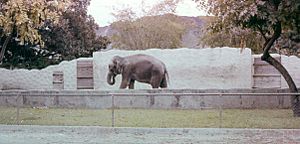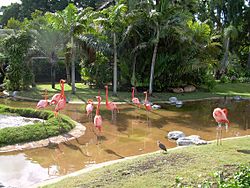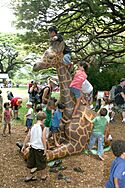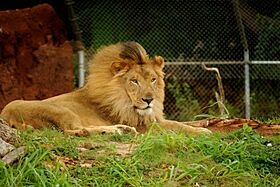Honolulu Zoo facts for kids
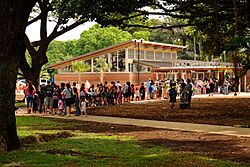
Main Entrance
|
|
| Location | Honolulu, Hawaiʻi, United States |
|---|---|
| Land area | 42 acres (17 ha) |
| Coordinates | 21°16′15″N 157°49′09″W / 21.2709°N 157.8192°W |
| No. of animals | 1,230 |
| Annual visitors | 750,000+ |
| Memberships | Association of Zoos and Aquariums |
The Honolulu Zoo is a fun place to visit in Honolulu, Hawaiʻi. It covers 42 acres inside Queen Kapiʻolani Park. This special zoo is the only one in the United States started by a king! It was built on land from the royal Queen Kapiʻolani Park. The Honolulu Zoo is home to over 1,230 animals. They live in habitats designed just for them.
More than 750,000 people visit the zoo every year. The City & County of Honolulu manages the zoo. The Honolulu Zoo Society helps by providing programs and support. The zoo is a member of the Association of Zoos and Aquariums (AZA). This means it meets high standards for animal care.
Contents
History of the Zoo
Queen Kapiʻolani Park's Beginning
In 1876, King Kalākaua wanted to create a big public park. He made royal lands near Lē‘ahi available for this idea. Two hundred people joined together to help the king. They formed the Kapiʻolani Park Association. In 1877, the area was cleaned up and made beautiful. It opened as Queen Kapiʻolani Park. This park was named in honor of Queen Kapiolani, King Kalākaua's wife.
Even as a public park, King Kalākaua kept his own collection of exotic birds and horses there. The park also hosted events like Kamehameha Day celebrations. These events often brought more interesting animals to the park. In 1896, the City & County of Honolulu took over managing Queen Kapiʻolani Park.
How the Honolulu Zoo Started
In 1915, Ben Hollinger became the Administrator of Parks and Recreation for Honolulu. Queen Kapiʻolani Park came under his care. Hollinger loved animals and started collecting them. He wanted to show them off at the park in Waikīkī. Soon, the park had a monkey, a sun bear, and several lion cubs.
In 1916, a steamship arrived in Honolulu Harbor. It was on its way from Australia to Canada. On board was an African elephant named Daisy. Hollinger asked the City & County of Honolulu to buy Daisy. They did, and with Daisy's arrival, Honolulu officially had a zoo! Daisy entertained visitors until 1933. Sadly, Daisy was involved in a serious incident and was later put down by authorities.
During the Great Depression, the Honolulu Zoo almost closed. There was not enough money to keep it going. But even with difficulties, the zoo grew. In 1949, it bought more animals. These included another elephant, a Bactrian camel, sea lions, many bird species, spider monkeys, and a tortoise. The Honolulu Zoo continued to operate, even though it needed repairs.
In 1974, the zoo received donations of a camel, an elephant, chimpanzees, and deer. These gifts made people excited about the zoo again. The City & County of Honolulu approved a plan to improve the zoo. The plan set the boundaries for the current 42-acre site. New homes were built for the animals. The zoo's design was inspired by the San Diego Zoo in California.
The Honolulu Zoo became even better in the 1990s. Its exhibits were redesigned to look more like the animals' natural homes.
Art at the Zoo
The Honolulu Zoo has many interesting art pieces. Here are some of them:
- Giraffe, a metal sculpture from 1959 by Charles W. Watson.
- Hawaiian Porpoises, a sculpture from 1976 made of metal, fiberglass, and coral by Ken Shutt.
- Hippopotami, a sculpture from 1976 by Jack Throp.
- Elephant's Child, a bronze sculpture from 1988 by Tom Tischler.
- Gecko's Delight, a wood sculpture from 1978 by John Nippolt.
- Hawaiian Pigs, a stone sculpture from 1976 by Gregory Clurman.
- Giraffe, a fiberglass sculpture from 1998 by Jim de la Torre.
- Whooping Cranes, two metal sculptures from 1998 by Paul Saviskas.
- Maasai Tribesman, a metal sculpture from 1999 by Paul Saviskas.
- The Evolution of an Island, a metal mural from 1991 by Amanda Opsahl.
Conservation Efforts
The Honolulu Zoo works hard to protect animals. They focus on saving native Hawaiian species. They also work with other groups that care about conservation. The zoo helps animals like the Kamehameha butterfly and the nene. The nene is the state bird of Hawaii. They also help crocodile monitor lizards, birds-of-paradise, African wild dogs, and sloths.
In 2015, only one Amastra cylindrica snail was found in the wild. The zoo stepped in to help. They worked to increase the number of these snails. More than 140 snails have since been released back into the wild. This shows how dedicated the zoo is to saving endangered species.
Gallery
-
American flamingos featured at the entrance to the zoo
-
Asian elephant (Elephas maximus)
-
Greater kudu (Tragelaphus strepsiceros)
-
Violet-backed starling (Cinnyricinclus leucogaster)
-
Radiated tortoise (Astrochelys radiata)


